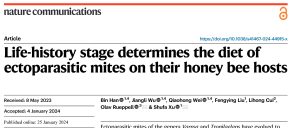The world is often complicated. This turns out to be true also for the feeding habits of the ectoparasitic mite Varroa destructor. The long-held belief that Varroa was primarily feeding on the blood (hemolymph) of its honey bee hosts was overthrown by a paradigm-shifting study by Ramsey et al. in 2019, which demonstrated that dispersing Varroa primarily feed on fat body of their adult honey bee hosts. This should be adaptive, given that the fat body is readily accessible from the mites’ hiding spots between the bees’ abdominal segments and the fact that adult honey bees do not contain a lot of hemolymph. However, in our more comprehensive study, we could show that during the reproductive phase that is spent on honey bee brood, Varroa primarily feeds on the hemolymph, similar to another bee mite, Tropilaelaps, which only feeds on bee brood. This complex alternation of feeding habits in accordance with the life stage of parasite and host is a reminder how complex biological interactions are and that we must continue our quest for understanding the natural world around us.

